A True Story of the Determination to Survive.
In December of 1942, a Martin B-26 “Marauder” Medium Bomber of the 440 Sqn, 319 Bomb Group the “Times A Wastin” with a crew of 7 left Narsarsuaq Greenland (code name Bluie West One) heading back to the United States. The weather turned sour and the pilot was forced to crash land at the head of the Saglek Fjord in Labrador. The aircraft sustained minimal damage and the crew survived the impact unscathed. What follows is taken from the pilots diary and documents their efforts to survive in one of the most unfriendly and hostile landscapes on earth at the worst possible time of year. The original transcript of the pilots diary was included in the formal report filed by the USAF team that recovered the remains of the crew on April 18,1943. Maj. Vaughan, Lt. Holmes and Lt. Norton accomplished the recovery by landing at the Inuit settlement of Hebron (below)
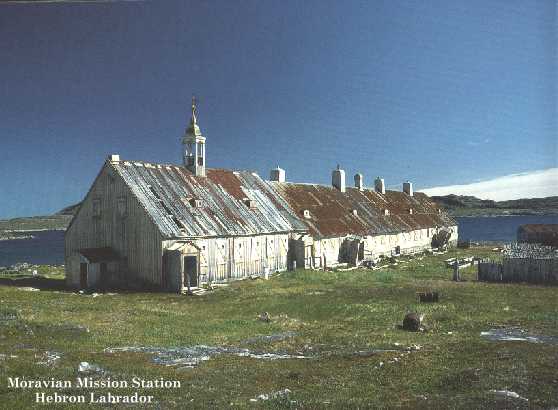
and walking overland to the crash site. The bodies were returned to Crystal-1 (Fort Chimo, now called Kuujjuaq) on April 22, 1943 where a funeral service and interment took place in the US Army cemetery plot the following day. The version of the pilots diary that appears here was prepared by USAF personnel of the 1932nd Communication Squadron Goose Bay Labrador, year unknown. Except for names and places, spelling and punctuation have been retained as they appeared.

B-26 Marauder similar to “Times A Wastin”. Courtesy of United States Airforce Museum.
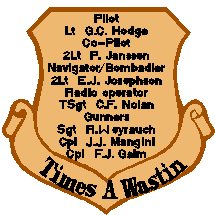
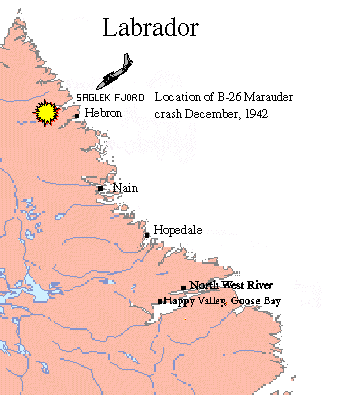
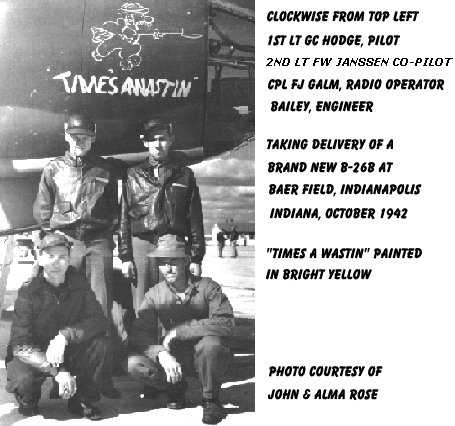
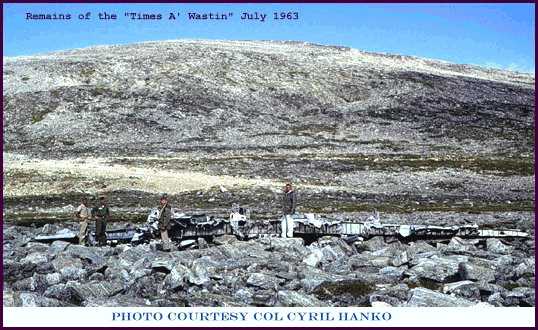
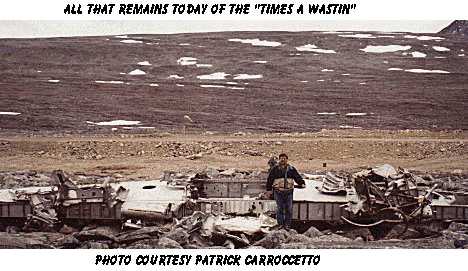
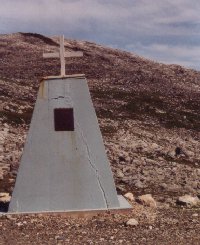

Above: Monument erected in 1963 showing typical area landscape photo courtesy of Patrick Carroccetto.
August 1998
Fifty-Six years after the crash, and after more than fifty years of trying, the Hodge and Rose family finally visit the crash site and rededicate the memorial located there. Shown are Alma Rose and Bill Hodge, sister and brother of the pilot, holding the new plaque which will be affixed to the cairn behind them.
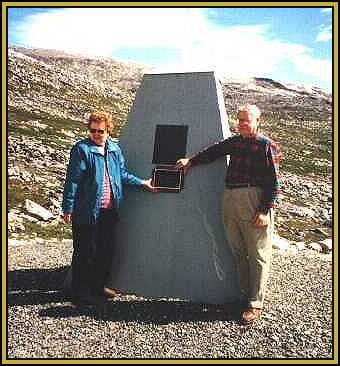
Below: North Warning System Long Range Radar Station at Saglek today

The 1932nd Com Sqn Presentation:
A TRAGEDY – VINTAGE 1942
PRESENTED BY
THE 1932nd COMMUNICATIONS SQUADRON (AFCS)
GOOSE BAY AIR BASE, LABRADOR, CANADA
High on the coast of Labrador (Canada), the icy waters of snow fed streams flow to meet the sea through the steep, rocky walls of Saglek Fjord. Between June and October they flow, but for the remainder of the year all exposed water is frozen, often to the depth of several feet. Archaeologists have uncovered residue of ancient residents who hunted and fished the waters of the fjord as early as 2580 BC. Their stone hearth, with charcoal still intact, has been uncovered on Rose Island in the mouth of the bay.
Today, a small US Airforce converted radar site houses a tropospheric communications link to the northernmost outposts of our hemispheric defence system; from the steep heights, US contractor maintenance personnel overlook the vast stretches of frozen tundra and infrequently visible blue-green of the Atlantic. NB: This site is currently (in 1998) the location of a North Warning System Long Range Radar Station. On a flat stretch of this barren land, at the base of the steep bluff now crowned by a radome and the concave, billboard antennas of the site, our story finds a setting. No more than fifty yards from the present site runway, lie the weathered remains of a B-26 medium bomber of World War II vintage.
On 10 December 1942, the 1800 foot cliff overlooking the ocean and Saglek Bay witnessed the beginnings of a tragedy. Although only a few miles from an Eskimo village, none of the crew walked out. On December 23rd three members started south in a boat that was part of the aircraft’s emergency gear. They were never seen again. The remaining crewmen stayed with the downed plane, existing for months in sub-zero temperatures in the belief that help would arrive. The diary of the B-26 pilot has been retained intact – the last entry added was in February 1943.
The story begins at BW-1, Narsarsuaq Greenland, as the long arctic winter has shortened the days and winter is closing in as the seven man crew awaits clearance for the flight home – first stop Goose Bay, Labrador.
The Diary Begins
NOVEMBER 12, 1942
We’re still sitting here with 16 minutes (less) of daylight each day. We’ve less than six hours of daylight between sunrise and sunset now. Had about two inches of snow last night and everything was really pretty. Spent most of the morning sweeping it off the plane. They said that there’s a chance of leaving tomorrow but this place seems so much like home that it doesn’t seem like we should leave.
NOVEMBER 16, 1942
This place is full of changes. Yesterday afternoon Jansen and I walked down to the river. There was a solid sheet of ice resting on the rocks, and it was covered with almost two inches of snow. Every once in a while, we would break through up to our knees, but there was nothing under the ice. Last night we had rain with a warm wind with gusts up to 60 miles per hour. So this morning there was only isolated patches of ice left. today was the first time in two weeks that we have been able to walk on bare ground. We’ve had all kinds of weather, most of the days were fairly warm. But one day it was six degrees. We’ve seen days when not a breath of air stirred.
NOVEMBER 26, 1942
I still say this is screwy weather. We were alerted this morning at 0330. There was a solid overcast. We killed time until 0600 when we got briefed. It was still overcast and seemed to be getting worse. The A-10s and B-25s started kicking off, but about then it started to rain and the ceiling looked like it was very low. About 10 minutes later it stopped raining and an A-20 came over at 600 feet with room to spare. By 0830, the sun was shining and everything looked as nice as we could ask for, but it was too late to take off.
DECEMBER 10, 1942
Took off at last for Goose Bay. About one hr 15mins out, we ran into some clouds and I turned around and called for the formation to turn around also. One plane dropped out. I think I saw the P-40s later. I lost the others while letting down below the clouds. We saw an opening to the south at about 2000 feet and after flying in that direction we broke out. We finally had to go back up to 13000 feet, but it was clear sailing, so we kept on. Lt Josephson gave me a new heading to get back on course, but we know now it was too much of a correction. About halfway I picked up goose beam, but the set went dead after a few minutes. It was too late to turn back then, so we tried to get it on the compass, but couldn’t. We finally hit the coast. We decided we were south of Goose Bay, so we turned north until we finally realized we were north. We were almost out of gas, so I started looking for a place to land. I wanted to get back to where there were trees, but the engine started missing, so we came back down. The crew never batted an eye when they were told that we were going to have to make a crash landing.Even if I do say so myself, it was a good landing and Lt Josephson did a good job cutting the switch. We hit a rock that tore the bombay open and one prop tip went through the fuselage behind me. Outside of that, the ship was intact. It swung around almost 90 degrees without stopping, but made a good wind break that way; it was almost dark so after eating a cold ration we went to bed inside the ship; we had 17 blankets, a comforter and a bedroll, but we slept very well. Lt Josephson took a star shot and decided we were 300 minutes from goose.
DECEMBER 11, 1942
Lt Josephson walked to the fjord to the west and Galm the one to the east. We spent most of the day clearing up the ship and pooling rations in the afternoon. I climbed the mountain in front of us (where Saglek Air Station is located), but didn’t learn much. Nolan worked on the putput all day without results. We cranked the dingy radio. It was pretty windy so we spent the night in the ship.
DECEMBER 12, 1942
Made three big improvements in our situation. Lt Janssen and Galm discovered a lake close to our ship and saw a fox. Weyrauch and I saw 50 seals; so we know that there is food here. We made a lean-to out of tarp under the wing and slept there. It was much better.
DECEMBER 13, 1942
When the star shots were figured out it showed us to be close to the town of Hebron. Worked on the putput all day without success, so we tried to work the liaison set on the batteries but they were too weak. We pooled our covers and slept together.
DECEMBER 14, 1942
Wind blew all day with increasing velocity and snow. Our lake went dry so we were back to melting snow. Went to bed early.
DECEMBER 15, 1942
Had to eat a cold breakfast because the wind blew too much snow in our fire. Nolan changed the voltage regulators and got 25 volts, long enough for me to get a couple of stations on the liaison receiver. The putput stopped, but we hope we know what is wrong with it. So we hope to get a message out soon.
DECEMBER 17, 1942
The putput went out, but we did try the batteries. They too, were dead.
DECEMBER 19, 1942
More snow last night. Nolan and Mangins tried to work on the putput but it was too cold. We built a fire in the lean-to and thawed out.
DECEMBER 20, 1942
It was so windy we stayed in bed all day.
DECEMBER 21, 1942
Everything was really snowed in so we spent the day eating and thawing out blankets and planning a trip south. Lt Josephson Lt Janssen and Sgt Nolan plan to head south in the boat the first clear day.
DECEMBER 22, 1942
Had a perfect day, the first clear day in over a week. We worked on the boat and cleared snow away from the lean-to all day. We ate a pretty big meal with the three boatmen eating a little extra.
DECEMBER 23, 1942
Got up at 0715, got the boat ready and started carrying it. The wind was pretty strong and the boat was heavy, so we had a pretty hard time of it. We didn’t get to the water until noon and then it took quite a while to find a place to put it in the water. We intended to put them off shore, but they appeared to be making slow headway to the south. That was the last time we saw them. We had a hard time coming back across the snow. We had some peanuts and caramels and went to bed.
DECEMBER 24, 1942
Christmas Eve and we’ve been here two weeks today. It was lonesome with just the four of us, but we got up pretty early and dug out the gas strainer so we could make a fire.It was so windy we couldn’t work outside so we dried out blankets. Galm got blisters pretty bad and swollen hands which have to be doctored. We stretched out our eating to cover most of the day. We had a sardine sized can of herring with crackers, a spoonful of peanuts a piece, a black cough drop, and a caramel, a cup of grape drink, and plenty of coffee, using the same grounds over and over. It’s really a surprise how much one can get from a small thing like a caramel, but we look forward to it with anticipation each day.
DECEMBER 25, 1942
What a Christmas. Mangins’ feet pained him so much we had to get up at 0330. He was in agony before that, but was better after, although his arches pain him pretty bad. Got up again at 0900. Galm went exploring, I massaged Mangins’ feet and Weyrauch started fixing up the floor, which was in pretty bad condition from the fire. Later we had to dig out the rear entrance to the ship to fix the window up. After that, we had a first aid lesson. The only one who doesn’t have anything wrong is me. We are about to eat our Christmas dinner and go to bed.
DECEMBER 26, 1942
Had another swell day. The weather was perfect. Weyrauch cleaned up the back of the ship, while Galm dug around in the rear of the bombay, uncovering a can of fruit cocktail and a can of chicken a la king. I worked on Mangins’ feet and did some odd jobs. Everyone is feeling better, and I hope that Mangins will be up in a few days. We aren’t starving by any means, but the conversations are mainly about food. One surely can remember some tasty food.
DECEMBER 27, 1942
Started today as usual by treating the casualties. Mangins’ feet are better, but we found a big blister on each foot. Galm and Mangins spent the day drying blankets. Weyrauch finished cleaning out the back of the ship, and I climbed the mountain to see if I could see anything out to sea. I also took a roll of film. The enforced diet is beginning to tell on us, but we’ll eat a little more tomorrow.
DECEMBER 28, 1942
This has been a terrible day. The wind started up early in the morning and has kept us inside all day. We had two fires which took the rest of the day to repair. Mangins’ feet are quite a bit better and he will start working on the putput soon. We may get the liaison set going yet. In the meantime, we can feel the effects of the short rations more every day. We pray almost every minute that the boys in the boat will get through soon and get some help.
DECEMBER 29, 1942
Today has been just average. The wind started up early again, but not too hard. Mangins’ feet are almost back to normal.
(NOTE: The following is in different handwriting)
Yet, if the taste of kisses went and strawberries came the year round, half of the joy would be gone from the world. There is no wonder we kiss for when mouth comes to mouth in all its stillness, breath joins breath, and taste joins taste. Warmth is enwarmed, and tongues can move in a soundless language, and those things are said that cannot be said, have a name or know a life in the pitiful faults of speech. There is nothing to be done with the ear, so back we come to the organs of taste and smell. It is temple of the voice, keeper of the breath, treasures of tastes and home of the noble tongue. And its portals are firm, yet soft with the warmth of a ripeness unlike the rest of the face, rosy and in women with a conkling red tenderness of the taste, not to compare with the wild strawberry feeling and far from the organs of taste and smell, and far from the brain, and an arms length from the heart. To rub a nose like the blacks and it is better than nothing at all, but there is nothing to the taste about the nose, only an old piece of bone pushing out of the face, and a nuisance in time of winter, but a friend before meals and in a garden indeed. With the eye we can do nothing, for if we come too close they become crossed and everything comes twice and sight without good for one or all five, no angles with a fluring world yet this it was that left the grapes to weed. I had eaten of the tree. Eve was still warm under me. there is strange and yet not strange in the kiss; it is strange because it mixes stillness with tragedy and yet not strange because there is good reason for it. The hand is too hard and too used to doing all things with too little, and deeper and closer.
DECEMBER 30, 1942
Today was overcast with snow showers. Spent most of the day working on the inside. Galm lost a fingernail, and may lose another. I’m just thankful that his hand doesn’t pain him. Worked a little on the putput and made some progress, but it was too dark to work much. Got up a game of 500 Rummy which everyone seemed to enjoy. The boys have been gone a week today, God grant they are still going.
JANUARY 1, 1943
Happy New Year. It snowed and blew all night long and kept it up all day. So since we had no fire we stayed in bed all day.
JANUARY 2, 1943
More wind and snow today. It slackened up a little around noon, so we got up with the aid of a fire in a peanut can. Weyrauch got the prop and receiver tank out with a gallon of alcohol and glycerine, and I dug out the oil drain. After that, we had a couple of hot fires and plenty of hot coffee and had a lemon powder and a cup of bouillon. Our main dish was the last can of datenut roll with jelly and it was very good. We didn’t finish with the eating and drinking until almost noon. Then I worked on Mangins’ feet and went to bed. There was quite a bit of loose snow outside but the very shape of our ship keeps it fairly clean. It actually rained today and I don’t know what effect that is going to have on out situation. The boys have been gone ten days today, which is the time we figured it would take them to make the trip. We hope they made it and can bring help soon.
JANUARY 3, 1943
There wasn’t much wind last night so we thought we would have a good day, but the wind picked up and it snowed all day. The ship had a sheet of ice on it and is covered with snow. Besides that, the drifts are higher and closer than they have ever been before. We hooked up the fuel transfer pump and I’m positive we pumped some gas over to this side but we couldn’t get it to drain out so we had to use the alcohol to cook with. I got into a big hurry once and caused a fire in which I got burned but not badly. Now we are all wearing bandages. I found two bouillon cubes in the radio operator’s desk. Spent a lot of time putting snow under our bed. There was quite a hole there, so we should be able to sleep better tonight. It must be raining outside now. It couldn’t be melting ice on the wing. We keep praying for clear weather and hope that the boys get through. Also to try out a new theory to where Hebron is.
JANUARY 4, 1943
Had a blue sky when we got up, but it stayed overcast all day. There wasn’t much wind, however, so we got up and went to work. Weyrauch and I got quite a bit of gas out of the other wing, so we are pretty well fixed on that. Mangins has the putput almost ready to try again. We are just praying for good weather both in hopes of a rescue plane (if the boys got through). I am cutting down still on the rations.
JANUARY 5, 1943
It started off like a beautiful day, but turned to a light low overcast. Weyrauch and I cleaned the plane of snow and Mangins finished the putput, which seems to be in pretty good shape. It started clearing late this afternoon.
JANUARY 6, 1943
This is the eighth day of bad weather. The entrance is blocked, and it doesn’t do any good to dig it out. It has been two weeks since the boys left and spirits are still high in spite of the bad weather.
JANUARY 7, 1943
We’ve been here four weeks today. The entrance was blocked up this morning. As I was going into the ship, I saw a little bird. We caught him and boiled him for a couple of hours. Then made a stew by adding a bouillon powder. It was really delicious. Galm started to go looking for Hebron, but the snow was too soft. Mangins got out for the first time in 13 days. If we can’t find a town or get the putput going in three days, we are going to have to sit and wait until the weather clears and pray that the boys got through because we are too low on food to do anything else. God help us to get out of here safely.
JANUARY 8, 1943
Today was the most strenuous for me since we got here. I tried to get to Hebron, and I still think I know where it is, but there are two mountains in the way. I can feel myself growing weaker and we have less to eat every day. I don’t know what we would do if we didn’t have that three pounds of coffee. We sit around and drink that and talk about all kinds of food, but I think we all crave chocolate candy more than anything else. The boys have dug out the back of the ship so if tomorrow is clear, we still have one last try with the putput radio.
JANUARY 9, 1943
Well, we put the putput back in its place and it jammed again, so that leaves us with one possibility, that the boys get through.
JANUARY 10, 1943
We have been here one month today, 31 days. spent most of the day which was perfect as far as the weather was concerned looking for the plane and fixing up bandages. The boys spirits were much higher today after our little church service. Our only food today was a slice of pineapple and two spoons full of juice.
JANUARY 11, 1943
Our third day of perfect weather, also the coldest day since right after we got here. Spent the day watching for the plane which didn’t come. The oil gave out on this side, which brings about another problem. The short rations are beginning to tell on us, but we are still in high spirits. If we don’t live to eat some of the food we talked about, we’ve mentally eaten one of the best meals in the world.
JANUARY 12, 1943
Today was the boys’ 20th day and our 33rd, and was overcast, but was calm. We got the oil almost dug out but are all so weak that we can hardly work. The boys spirits are still high though, and we had a couple of lively bull sessions on our one topic, food. Our ration today was a slice of pineapple.
JANUARY 13, 1943
Another calm overcast day. We dug up the oil, dried out blankets, made a new bed on snow and ate our last food, a slice of spam and a soda cracker a piece. All we have left is a half pound of chocolates and three drink powders, but we talk like rescue was certainly tomorrow. It cleared off late this afternoon, so maybe there is hope for tomorrow.
JANUARY 14, 1943
Clear day but with wind. We cleaned off the plane and waited, but nothing happened. Late this afternoon we were playing cards when Mangins oiled the gas to fast and caused an explosion which burned both his and my face, hair, and hands. Our rations were four chocolates, but we are still working out pretty well. After a devotional, we went to bed.
JANUARY 15, 1943
A perfect day as to weather, but the coldest since we got here. Spent most of the day trying to keep warm and listening for a plane. Also made big plans for a couple of days in New York when we get our furloughs. Rations were two chocolates and a bouillon powder. No one is particularly hungry yet, but we are getting weaker and colder because our bodies aren’t putting out enough heat.
JANUARY 16, 1943
Another calm clear day, but the coldest we have had yet. The oil froze up, so we had to end up burning nothing but gas. The only thing we have left is one bouillon powder and two sticks of gum. The strain is beginning to tell, but we still have good bull sessions about food and the furlough in New York.
JANUARY 17, 1943
Couldn’t have asked for a better day except that it is so cold that the oil is frozen and won’t burn. So our gas is going pretty fast. Had our last food, bouillon powder, so unless rescue comes in a few days ——-. the boys have been gone 25 days which is a long time, but they are our only hope; our families will really miss some swell dishes and menus.
JANUARY 18, 1943
Cold and clear. my watch stopped, so we didn’t get up until noon. Must be a little warmer because we got a little oil. Today was our first complete day without any food, but spirits are still pretty high. It’s surprising how much punishment the body and mind can take when necessary. We are still in pretty good condition but rather weak. Not much hope left.
JANUARY 20, 1943
It snowed and blew all night, but we slept pretty well, and we were much more cheerful today. We stayed up longer than we should have though and are pretty tired. That snow has been blowing pretty hard all day and is piling up in front of the door, so I don’t know what we will do if it doesn’t stop pretty soon.
JANUARY 21, 1943
Six weeks today and rough night with snow and rain, so everything was soaked when we got up. Only Weyrauch and I got up and then only long enough to melt snow for water. Things could be worse.
JANUARY 22, 1943
Got up around noon, and was up until about 6. I cleared up the entrance and made the bed. We could stand some good weather.
JANUARY 23, 1943
Spent a miserable night. Everyone got crowded and nobody could get comfortable. Had a good day, but everybody is pretty discouraged, although the conversation was pretty good. We haven’t really felt famished but we are really weak. It really gets me to see these boys start to do something and have to stop from the lack of power to go on. Weyrauch has developed a case of piles and is really suffering.
JANUARY 24, 1943
Overcast but fairly calm. Each day we don’t know how we can last another day, but each time we manage to go on. We all smoked a pipe of tobacco this morning and Galm got really sick, and I felt pretty bad. But we came out pretty well.
FEBRUARY 3, 1943
Slept a solid week in bed. Today Weyrauch died after being mentally ill for several days. We are all pretty weak, but should be able to last several more days at least.
NOTE:
This is the last entry in the diary. The remains of the crew were found April 9, 1943 by Eskimos from Hebron, only about three and one-half hours walk away.
LIST OF FOOD WHEN LANDED:
7 cans of Spam, 3 cans of peanuts, 8 cans of chicken, 2 cans of pineapple, 3 cans of fruit cocktail, 2 cans of date-nut roll, 1 can of brown bread, 3 boxes of chocolates, 28 Hershey Bars, 4 packages of dates, 1 pound of crackers, 4 boxes of fig newtons, 1 pound of cheese crackers, 1 case of Coke, 2 cans of salmon, 3 pounds of coffee, and 20 packages of caramels.
Many thanks to all those who have helped to tell this story.
Special thanks to Mr Bill Hodge , brother of the pilot. and Maj (ret.) Rex Harris, the Saglek veteran responsible for erecting the monument.
For more info on the B-26, visit B26.COM
